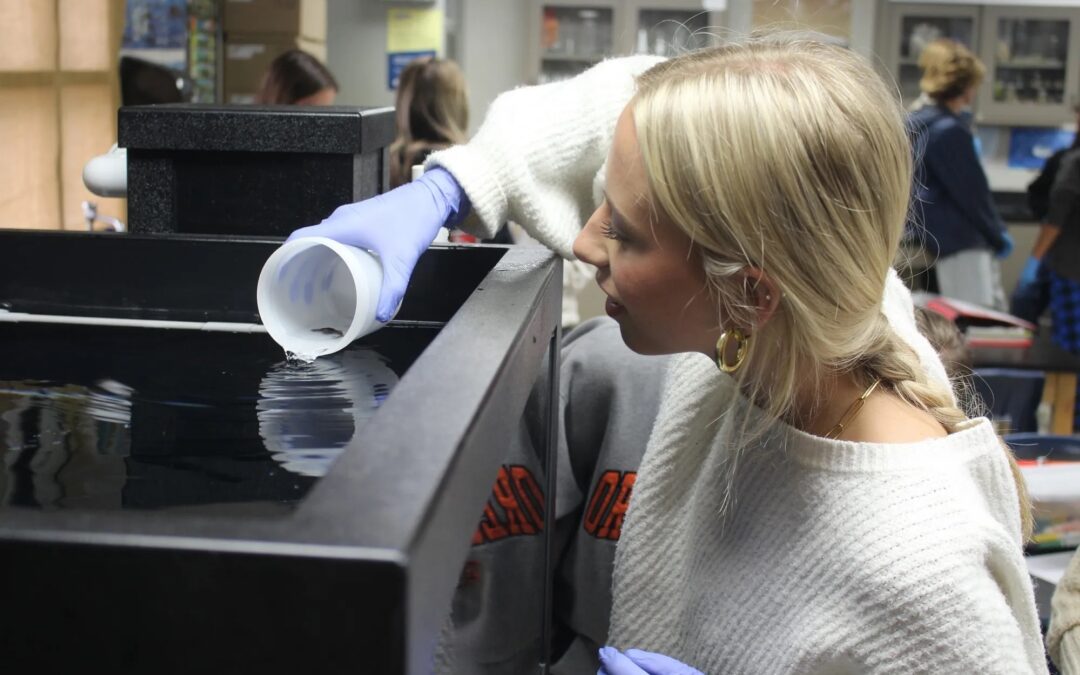Contacts:
Peter James MacCracken, APR | pjm@strategic-communications.com | (619) 275-4110
Celina Maggi | cmaggi@hswri.org | (619) 909-3449
Ecological Endeavors: High School Students Take on Challenge of Raising Sea Bass
By C. Jayden Smith
While the International Baccalaureate Marine Science course at San Clemente High School typically includes hands-on activities, students in Michelle Breslin’s classes will embark on a task this year that no one at the school has done before.
Classes this week have begun caring for 42 young white sea bass as part of Get Inspired and the Hubbs SeaWorld Research Institute’s (HSWRI) efforts to restore the once-depleted California species.
Nancy Caruso, a marine biologist and founder of the environmental stewardship organization, and HWSRI Education and Outreach Coordinator David Tabor were at SC High on Tuesday morning, April 11, to kick off the roughly 1½-month process of raising the fish.
The students’ objective is to feed the fish, currently measuring just centimeters long, and monitor and clean the fish tank until the group grows big enough to be released into the Pacific Ocean.
Tabor said it was important for the sea bass to keep eating a significant amount until the days leading up to the release.
“Here, we’re going to be in the stage where we’re almost overfeeding or giving them more food than they (need), just so we know that they’re satisfied,” he said.
Throughout the process, Caruso will teach the students about aquaculture practices, career opportunities in the marine field, and how the tank method of raising the fish contributes to the popular seafood item’s stock in the wild.
San Clemente High became the 12th school to work with the partnering entities on such a project. The students started by establishing the initial weight of the fish that they’ll use to compare at the end of the project, then poured the fish into the tank.
Caruso advised the first-period class to wait a day before feeding so that the fish could acclimate to their new environment.
Junior Molly Graff, who has always held an interest in the ocean and the environment, said that she was “all for it” when she heard the project was coming to her classroom. She was actively involved in checking on the tank in the lead-up to Tuesday’s delivery.
“It’s just knowing that I’m making a difference in the world and the environment,” said Graff, adding: “That I’m helping it gives me purpose for this class and what I want to do in the future.”
Breslin’s classroom has had the tank in the back area for months, after Breslin and Caruso wheeled it into the room and Caruso equipped it with all the measuring and cleaning tools necessary to maintain the aquatic system.
The two go back more than a decade, as friends and as marine science enthusiasts who have collaborated on multiple projects for Breslin’s classes. Before the pandemic hit, they had plans to care for green abalone—another passion of Caruso’s—that was sidetracked but gradually came to be over the years.
Caruso then came to interview Breslin in early 2022 to gauge her interest and capability of managing the sea bass program.
Since her students conduct studies each year for her class, Breslin said the new project served as a practical addition to the other weekly labs and other hands-on activities.
“This is just what I like about this, that it’s a daily thing,” she said, adding: “I can ask them, ‘What should the salinity be?’ It’s not just memorization; it’s practical.”
Numerous factors contributed to the school’s acceptance into the project, according to Breslin. The funding left over from what would’ve been used for the abalone project combined with the support from Principal Chris Carter and other school officials, the Rainbow Sandals Foundation, and grant money provided by Caruso, turned the exclusive experience into reality.
Breslin expressed gratitude for Carter’s involvement.
“Sciences cost a lot more money (than other subjects),” Breslin said. “We have sharks and perch and clams that we dissect, so all that costs a lot of money with all our anatomy, but (Carter’s) been really phenomenal about helping us and making sure we can do the projects we want to do.”
Tabor said that the reasons for the HWSRI’s limited number of participants include the high costs that come with the project and the organization’s approach to expanding the program as it ensures its capacity to be involved. The institute has a “slow growth mentality,” he said.
All five of Breslin’s Marine Science classes will participate in raising the sea bass. The number of students alone is a testament to the campus’ growing interest in the field, especially with its proximity to the ocean and the number of students who either surf or enjoy being near the water in general.
Breslin added that partnerships with the San Clemente Ocean Festival or the Ocean Institute in Dana Point all contribute to the varying learning opportunities her students and those in other marine science classes receive.
“Over the years, it’s really been a community thing, and I feel like when we have other organizations and (create hands-on activities), it really sparks their excitement,” she said. “I can only do so much PowerPoint and lecture stuff. It’s fine, but there’s nothing like touching it and being out there. It’s 4-D.”
Caruso expects the fish to be ready for release by around May 28, at which point the students will release the sea bass at the Ocean Institute.
Link to Publication

